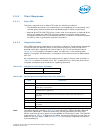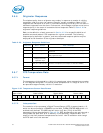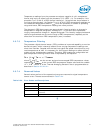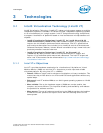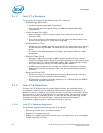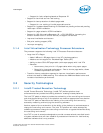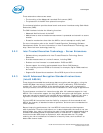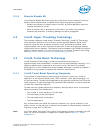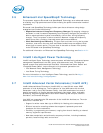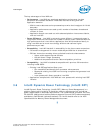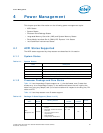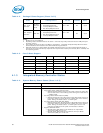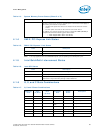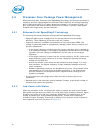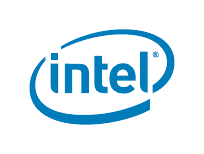
Intel® Xeon® Processor E5-1600/E5-2600/E5-4600 Product Families 83
Datasheet Volume One
Technologies
3.2.4 Execute Disable Bit
Intel's Execute Disable Bit functionality can help prevent certain classes of malicious
buffer overflow attacks when combined with a supporting operating system.
• Allows the processor to classify areas in memory by where application code can
execute and where it cannot.
• When a malicious worm attempts to insert code in the buffer, the processor
disables code execution, preventing damage and worm propagation.
3.3 Intel® Hyper-Threading Technology
The processor supports Intel® Hyper-Threading Technology (Intel® HT Technology),
which allows an execution core to function as two logical processors. While some
execution resources such as caches, execution units, and buses are shared, each
logical processor has its own architectural state with its own set of general-purpose
registers and control registers. This feature must be enabled via the BIOS and requires
operating system support. For more information on Intel Hyper-Threading Technology,
see http://www.intel.com/products/ht/hyperthreading_more.htm.
3.4 Intel® Turbo Boost Technology
Intel® Turbo Boost Technology is a feature that allows the processor to
opportunistically and automatically run faster than its rated operating frequency if it is
operating below power, temperature, and current limits. The result is increased
performance in multi-threaded and single threaded workloads. It should be enabled in
the BIOS for the processor to operate with maximum performance.
3.4.1 Intel® Turbo Boost Operating Frequency
The processor’s rated frequency assumes that all execution cores are running an
application at the thermal design power (TDP). However, under typical operation, not
all cores are active. Therefore most applications are consuming less than the TDP at the
rated frequency. To take advantage of the available TDP headroom, the active cores can
increase their operating frequency.
To determine the highest performance frequency amongst active cores, the processor
takes the following into consideration:
• The number of cores operating in the C0 state.
• The estimated current consumption.
• The estimated power consumption.
• The die temperature.
Any of these factors can affect the maximum frequency for a given workload. If the
power, current, or thermal limit is reached, the processor will automatically reduce the
frequency to stay with its TDP limit.
Note: Intel Turbo Boost Technology is only active if the operating system is requesting the P0
state. For more information on P-states and C-states refer to Section 4, “Power
Management”.



